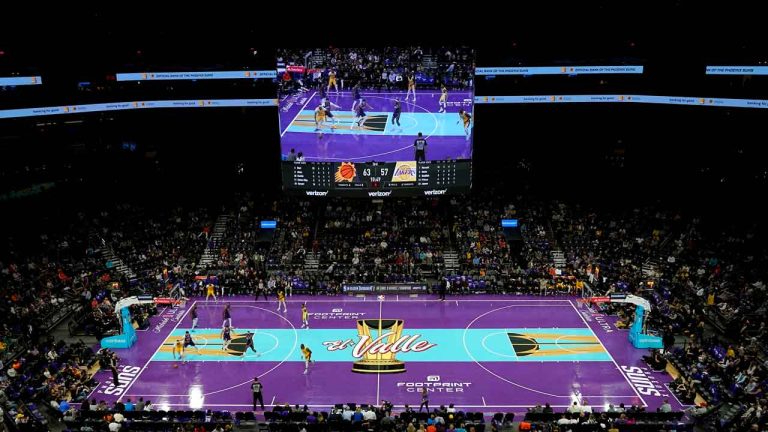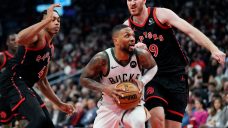It's fun, it's different -- at least for North America -- and it gives fans of NBA teams something beyond the Larry O'Brien trophy to hope for.
The NBA In-Season Tournament is in full swing and with some of Friday's action tipping off on Sportsnet, this feels like a good time to look at what’s worked and what hasn’t through the early stages of the tournament.
Different courts, designated NBA Cup days, increased intensity, that’s all part of what’s to like and not like about the NBA Cup so far:
What we like: Different courts
The idea of having different courts for NBA Cup games and telling viewers tuning in right off the bat that they’re watching something different is great. With the cup as part of the logo and the free-throw line it is impossible to tune into an In-Season Tournament game and not know you’re watching one.
Unique courts also add a fun element for the players. We all appreciate a change in our work environment from time to time and mixing up the court a little bit adds a fun dynamic for them, too.
"I like it," Miami Heat guard Tyler Herro said before a game in Milwaukee. "I think it's unique, it's different than a regular court, and the games that we're playing are different too, so it goes hand in hand."
What we don’t like: Poor court design and colour schemes gone wrong
First off, kudos to the Charlotte Hornets and Utah Jazz. Those courts look tremendous. There’s a few teams that we’re yet to see host an NBA Cup game – including the Raptors – but the majority of the courts just do not work.
It starts with the design. The runway style going from one key to the other destroys the functionality of the court aesthetics and with some of the colours teams are using, makes for an absolute eye sore. New Orleans Pelicans, here’s looking at you.
Generally speaking, the courts that work with this design are a darker shade down the middle and lighter beyond that. Strong, darker colours beyond the runway make for the most difficult viewing. The design needs to change and the colours need to be more functional.
What we like: Regular season games with added context
It would have been a tough sell to the players if the NBA Cup was a completely separate tournament and every team had several games stacked on top of an already demanding 82-game schedule.
By incorporating the group stage within the context of the regular season, the league has avoided that issue and made it a more manageable sell to the players.
In a perfect world, I think the tournament would run after Christmas and until the All-Star break when there’s a general malaise for the league but it’s easy to see why the NBA wouldn’t want to run up against the hottest time of the year for the NFL with this tournament.
What we don’t like: No group hype or inter-conference play
By informing the public of the groups through a press release that included explaining the format, etc., the lede got buried.
Unveil the group stage like FIFA does the World Cup or UEFA does the Champions League. OK, not entirely the way FIFA and UEFA do it back because that becomes a prolonged three-hour affair with way too much pageantry. However, there’s definitely room to add some intrigue for fans to know if their team is going to get stuck in a “group of death” or not through a televised event. Soccer fans are extremely tuned in for World Cup and Champions League draws and the NBA should follow suit.
Another big part of doing this successfully would involve increasing the variability of what groups could look like by having inter-conference play. No one cares about winning a division anymore and these groups have a very division-esque vibe since there are three Eastern Conference groups and three Western Conference groups.
What we like: Designated NBA Cup days
Having cup games on Tuesdays and Fridays lets fans set their internal clocks. People will know going forward that if they tune in on those nights in November and December then they will be tuning in for some NBA Cup action.
Viewership on ESPN has already been up 55 per cent relative to games played during the same timeframe last season and that would suggest the tournament has piqued some interest.
What we don’t like: Too many NBA Cup games at the same time
There have already been nights with multiple games coming down to the wire and it becomes a real challenge to multitask or decide on which game to watch. Borrowing from March Madness, the NBA could look to start games on one of the days in the afternoon and stagger them over the course of the day. This would require shifting the tournament from a Friday to a Saturday to still maximize attendance but it could be something that adds a tournament “vibe.” Perhaps this may be best suited for the final round of group games.
What we like: Teams taking the games seriously
It would have been a nightmare for the league if teams saw this the way English soccer teams view the Carabao Cup and prioritized playing time for their youngest players and the ones on two-way contracts.
Teams have taken the tournament very seriously thus far, even to the extent that we haven’t seen the usual waving of the white flag in garbage time. Because point differential is a potential tie-breaker, teams have trotted out their stars late in games on occasion to try and reduce the deficit and keep the damage of a defeat to a minimum.
What we don’t like: Some players making the format seem impossible to understand
There have been some grumblings from certain players that the format seems confusing and that they have no idea what’s going on. Steph Curry recently put any of that lack of understanding to bed with a quick explainer.
Six groups with five teams each, each team plays two at home and two on the road, the best team from each group advances. The two best second-place teams will also go through to form the quarterfinal matchups. It’s a knockout bracket based on seeding from there to determine the NBA Cup champion. Each player on the winning team (including those on two-way contracts) receives US$500,000. It’s really not that complicated.
For future consideration: Elam Ending
With a tournament that the NBA is trying to have things be as different as possible, it could make for an extremely interesting experiment if the league introduced the Elam Ending to NBA Cup games.
The NBA already uses it in its all-star game, the NBA G League uses it for games that go to overtime, and having a final target score to end fourth quarters should only add to the drama of the tournament. Who doesn’t want more game-winners?








COMMENTS
When submitting content, please abide by our submission guidelines, and avoid posting profanity, personal attacks or harassment. Should you violate our submissions guidelines, we reserve the right to remove your comments and block your account. Sportsnet reserves the right to close a story’s comment section at any time.